3D Scene Understanding and Imaging Its Situation
--- for Distance Learning and Lecture Archive ---
[Japanese],
Research Index,
Minoh Lab,
www.kameda-lab.org
2004/10/23
Abstract
Our research focuses on scene understanding of human working areas
by utilizing multiple sensors including multi-cameras.
In addition, we are working on intelligent (virtual)
cameramen and directors. Video archive and retrieval are also our
main research topics.
MULVIS-1
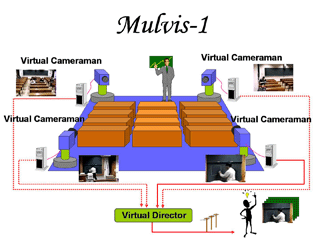
|
MULVIS-1 (MUlti-camera based Video Imaging System) is designed to
visualize a lecture in a classroom by using multiple observation/shoot
(8-12) pan-tilt cameras. A virtual director assigns the cameras to
virtual cameramen, gives them instructions of camera control, and
selects the best video image among them for broadcasting.
|
MULVIS-2
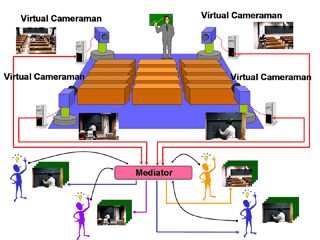
|
While the virtual director determines which camera to film
the object in focus in the classroom on MULVIS-1,
MULVIS-2 (Multi User Live Video Imaging System) can provide
customized video stream to each remote student
according to his/her preference.
This is a kind of a resource assignment problem since
the number of the pan-tilt cameras may be insufficient
to realize all the videos that they require.
|
Sensor Fusion Approach for Speaker Detection for Imaging
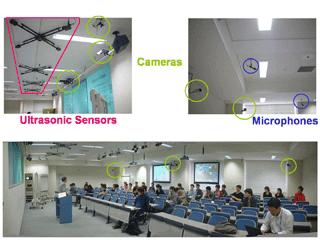
|
This is an improved version of MULVIS-1.
It uses not only image processing technology but also acoustic analysis
with microphone array and a position sensor to estimate speaker's
status more precisely.
|
CARMUL
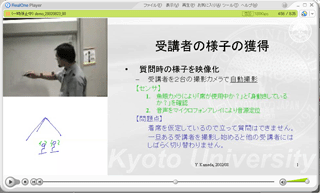
|
CARMUL (Concurrent Automatic Recording for MUltimedia Lecture) captures
and records all the kinds of information that emerge inside the classroom
during the lecture such as hand-writing on whiteboard, slides with
switching time, voices, and multiple videos of objects in the room.
|
Minimizing Camera Control Adjustment to Keep Specified Camera-work
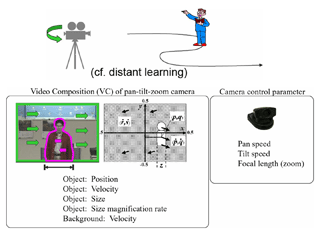
|
It is uncomfortable to see ticking video when a virtual cameraman
frequently changes rotation direction and speed so as to follow a
moving object. We propose a new method which dramatically depress
frequent adjustments by predicting camera and object status.
|
Brightness Control of Indivisual Objects inside A 3D Scene
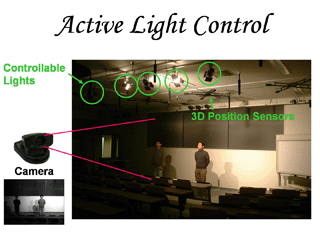
|
It is difficult to image two objects which are in different brightness
on one video frame. We propose a light control method that lights
each object indivisually in order to maintain their brightness
in good condition.
|
Publication
Please access appropriate articles in these lists.
Join us!
These researches have been conducted in
Minoh Lab
(of Kyoto University).
I am now conducting generalized research issues in
massive sensing project.
Please refer it if you are interested in my new approaches..
People who are interested in joining the projects may contact
Kameda or
Prof. Minoh
.
Members
As of 2003/03/31.
Leader :
MINOH Michihiko
Researchers :
KAMEDA Yoshinari (1996-2003)
NISHIGUCHI Satoshi (2001-)
YAGI Keisuke (2001-)
MUKUNOKI Masayuki (2001)
Tomasz M. Rutkowski (2002-)
KAKUSHO Koh (2003-)
Students :
KAMIYAMA Daisuke (1996),
KICHIYOSHI Kentaro (1996)
MIYAZAKI Hideaki (1996-1998)
MIYATA Shinji (1998)
ISHIZUKA Kentaro (1998-1999)
MURAKAMI Masayuki (1999-2001)
HIGASHI Kazuhide (1999-2001)
ATARASHI Yasutaka (2000-2002),
SHINGU Jun (2000-2002)
YOKOO Masahiro(2002-2003),
NIIZU Keiji(2002-),
MIKI Kenji(2002-2003)
kameda@image.esys.tsukuba.ac.jp,
kameda@media.kyoto-u.ac.jp
